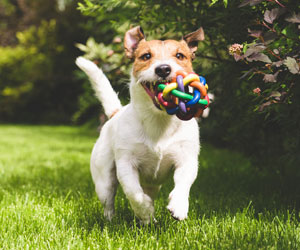Taking a Dog’s-Eye View of Social Interaction
 As many dog owners will likely attest, dogs appear to have pretty sophisticated social skills. Not only can they learn verbal commands, they can also follow a person’s gaze and respond to nonverbal signals, including pointing. But how do they know when a series of events constitutes a social interaction?
As many dog owners will likely attest, dogs appear to have pretty sophisticated social skills. Not only can they learn verbal commands, they can also follow a person’s gaze and respond to nonverbal signals, including pointing. But how do they know when a series of events constitutes a social interaction?
To find out whether dogs use contingency as a possible cue, researcher Tibor Tauzin and colleagues tested a group of 60 dogs, all family pets that were included in the Family Dog Research Database at the Department of Ethology, Eötvös Loránd University in Hungary. The sample included both purebred and mixed breed dogs, both males and females. The dogs were randomly assigned to one of three conditions: perfect contingency, high-but-imperfect contingency, and low contingency.
In each condition, the dogs watched a stuffed animal – either a crocodile or an owl – ride a remote-controlled car. A series of prerecorded verbal commands played over a speaker and the dogs observed the stuffed animals’ behavior.
In the perfect contingency condition, the stuffed animal always responded correctly to the command – that is, the crocodile would move toward the speaker when the command was “go,” move back and then forward when the command was “move back,” and turn and then move forward when the command was “turn.”
In the imperfect contingency condition, the stuffed animal obeyed two out of every three commands; in the low contingency condition, the stuffed animal obeyed only one out of every three commands.
In a test phase that immediately followed the observational phase, the dogs saw the same stuffed animal move toward one of two tennis balls. The dogs were then allowed to choose either ball and play with it for a bit before the scene was reset; they repeated this process three more times.
The results showed that dogs chose the tennis ball that was “chosen” by the stuffed animal more often than could be expected by chance when they were in the perfect-contingency condition, but not when they were in the other two conditions. Further analyses suggested that the frequency with which the dogs chose the same object as the stuffed animal was correlated with the level of contingency they observed.
The findings indicate that the dogs may use temporal contingency of actions to identify social agents – in this case, the stuffed animals.
“Thus, besides their ability to correctly respond to an agents’ gazing, pointing, or to verbal commands dogs might be able to identify an agent whose behavior should be monitored, even if that agent is unfamiliar to them,” the researchers write. “Agent identification, therefore, might help dogs to differentiate between social and nonsocial interactions, a skill that could also help them to determine whether an action is relevant.”
According to Tauzin and colleagues, dogs may be more sophisticated in their attention to and perception of social processes than previously thought.
Reference
Tauzin, T., Kovacs, K., Topal, J. (2016). Dogs identify agents in third-party interactions on the basis of the observed degree of contingency. Psychological Science, 27, 1061-1068. DOI: 10.1177/0956797616647518




APS regularly opens certain online articles for discussion on our website. Effective February 2021, you must be a logged-in APS member to post comments. By posting a comment, you agree to our Community Guidelines and the display of your profile information, including your name and affiliation. Any opinions, findings, conclusions, or recommendations present in article comments are those of the writers and do not necessarily reflect the views of APS or the article’s author. For more information, please see our Community Guidelines.
Please login with your APS account to comment.